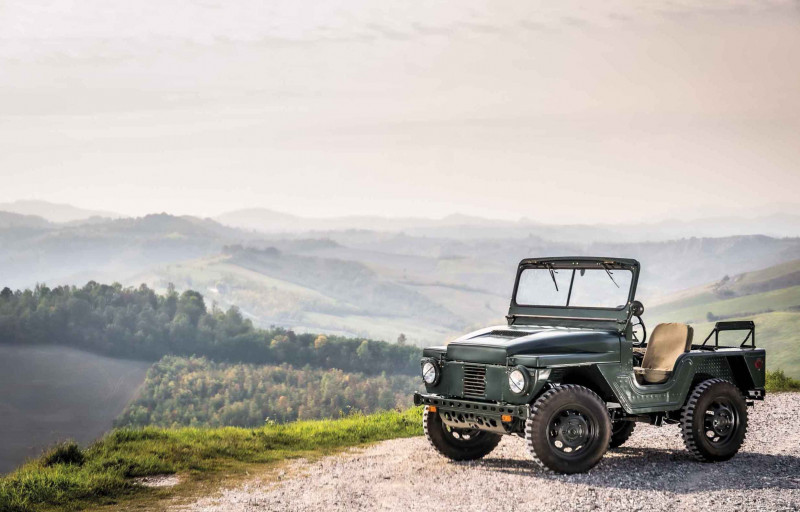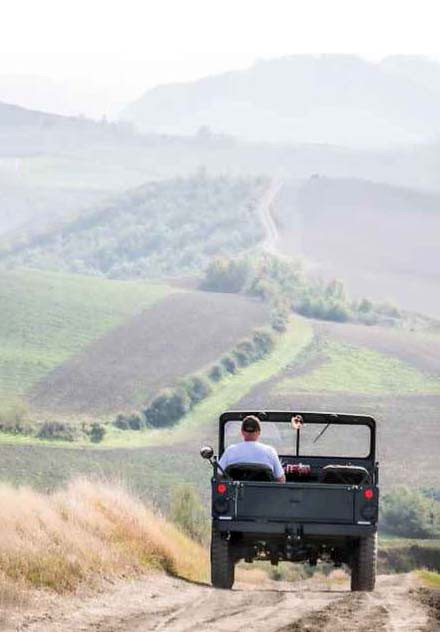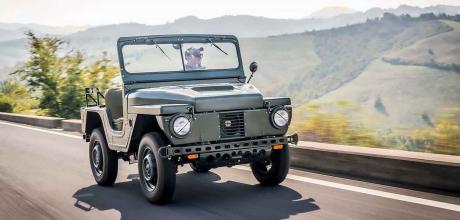1961 AMC Mighty Mite M422
The AMC Mighty Mite was developed for US Marines to transport by helicopter. Massimo Delbo drives a tiny unsung hero of tactical warfare.
Photography Max Serra
IT MIGHT BE GIANT
THE AMAZING MIGHTY MITE
Like a Jeep… but lighter, smaller, and rarer
An alloy-bodied, four-wheel-drive car propelled by a Porsche air-cooled engine, built from refined materials such as magnesium in an effort to save weight: it puts you in mind of a racing car, created to thunder along the Mulsanne straight. But in this case you’d be quite wrong. Welcome to the incredible — and very little known — world of the AMC Mighty Mite, an ultra-light quarter-ton 4x4 tactical off-roader, created specifically for the US Marine Corps for transport by helicopter.

Helicopters were a rare sight during World War Two; the American Sikorsky R-4, launched in 1942, was the first to be manufactured in series. In 1946, Marine Corps chiefs asked for a matching vehicle to be created for their troops, small and light enough to be lifted and transported by its Sikorsky H-19 aircraft, which had a 1202kg cargo limit, including crew and fuel. Those early helicopters had a limited carrying capacity and the ubiquitous Jeep was too heavy, hence the demand for a lightweight alternative.

The first prototype was built in the mid-1950s by the Mid-American Research Corporation to fulfill the Marines’ brief for a ‘vertical envelopment operations vehicle’. Called the MARCO MM-100, it was equipped with a riveted alloy body, independent suspension, limited-slip differentials, inboard drum brakes and a Porsche 356-derived air-cooled flat-four, the exhaust gases of which passed through chassis tubes to save the weight of an exhaust pipe.

The final version, code-named M422, entered production in 1959 after seven prototypes had passed the Marines’ gruelling tests. It had been developed directly from the MARCO prototype, and in its day was the lightest military truck ever manufactured, tipping the scales at only 771kg. The most important difference was in the engine: the Porsche unit couldn’t be used because the US military forbade German power. In its place came an American Motors Corporation (AMC) unit, also aircooled, but a V4 of 1766cc capacity. It was quite obviously inspired by the Porsche design and even looked similar, developing 52bhp with 901b ft of torque, enough for a maximum speed of 65mph.

The four-speed transmission featured full synchromesh and a very short first gear. It also permitted a shift from rear- to four-wheel drive while the vehicle was in motion, the transfer case being employed to engage or disengage the front axle.
Even the compact Jeep would dwarf it: the M422 was just 107in long (more than a foot shorter than a Mini!), 61in wide and had a wheelbase of 65in. It was homologated as a two-seater, with the potential to carry a further four people in an emergency on two additional fold-up seats integrated into the tailgate and another two folding backrests on the rear fenders. The declared maximum transportable weight was 390kg, which meant that each marine, complete with armaments, could weigh no more than 65kg.

Limited production was forecast — after all, this was a very specific vehicle created for a particular purpose within a single military corps. Nevertheless, the Mighty Mite (as it became known after the wife of a MARCO manager said ‘It looks like a mite, but a mighty mite!’) is well-engineered and assembled. The engineers had the foresight to waterproof the electrical system, while the differential housings and gearbox are protected and kept dry by the active pressure generated in the engine's crankcase.
In late 1961, after 1045 units had been manufactured, the M422 was replaced by the M422A1, a revised version, about 36kg heavier, with a wheelbase stretched to 71in and overall length also up by 6in. It was equipped with a spare tyre and a bigger, more protective windshield, and was produced until 1962, when 2672 had been built.

The car you see here is one of the early ‘SWB’ cars — a 1961 M422, chassis (and production) number 627 — that was found in Tennessee in the early 2000s. ‘It belonged to a trader who had several of them, in different conditions, all coming from the Marines’ surplus,’ says Marco Gordini, collector of 1960s-1980s military vehicles and owner of the 4WD Gordini shop in Bologna, which specialises in the restoration of classic off-roaders. ‘It arrived in Italy and I began studying every possible detail of a model that is not well-known and is very rare indeed. By 20141 had collected all the necessary parts and then the restoration took me a good five years: that’s about 600 hours of work.’
The job was not without its difficulties, the main one being that so few spare parts had survived. ‘The surviving Mighty Mite population worldwide is considered to be about 10% of total production. I've been lucky to find a specialist in Pennsylvania who had some stock, bought directly from the US military, and I was able to locate the most vital components of the engine. In the pre-internet era, for an Italian this would have been an impossible task. It still required a couple of journeys to the USA. I personally went through all the mechanical parts, while the body shop took care of the alloy body panels.’

Dismantling and then reassembling the chassis and the body was one of the trickiest aspects of the restoration. ‘Its construction is very sophisticated, like a piece of aeronautical engineering, with all the panels joined by rivets. Those rivets, thanks to their the age, are prone to corrosion and become loose, weakening the whole structure, and that meant we had to replace every single one. We are talking about a thousand of them! I found the right rivets, and the specific tools to attach them, in the USA from a company that manufactures parts for airplanes. It then took me about a year to get the Italian plate, so I could use it on the road. I also had to add homologated brakelights and indicators.’
The high original build quality has been helpful, however, as used parts from other cars have been straightforward to fit. ‘I’ve been amazingly lucky with the original fire- extinguisher,’ says Marco. I found one complete with its frame. When I bought it, I checked it against the car, and the two holes for the fixings were a perfect match. That is quite amazing when you consider how much handwork there was in the assembly of this product, and that it was made to fly with helicopters and be driven into swamps! You might have expected much less refined engineering and manufacturing quality, as these activities would shorten the life of the product.’
The gearbox and differential were provided by Dana Corporation, the best available at the time for off-road vehicle applications, and were known to be bulletproof.
‘The transmission is the most reliable part of the car, thanks to the over-pressure system to keep the internals dry' says Marco. ‘While working on the restoration, I often found myself admiring the quality of the materials used. I believe this explains why the car was so expensive to buy in period, with a cost of about $5000 for every single unit. Even so, the rear joint of the transmission shaft is not protected with an O-ring but has a greased rope-seal that, after getting hot and cold a few times, tends to leak.’
A notable aspect of the Mighty Mite career was its participation in the Vietnam war, where it was widely used in Marine Corps activity — though it wasn’t universally loved. ‘The car was — and is — good, but you can’t compare it with the contemporary M151 made by Ford, known as the “Mutt” [Military Utility Tactical Truck] and used by the Army. One of the main issues that affected the early M422 was potential loss, while being driven, of the rear wheels. It was caused by a fault in the design of the wheelhub, where the two conical bearings linking the wheel to the transmission were locked by a nut kept in position by a single cotter pin. Any slight damage to the cotter pin and your wheel was off. Marines often criticised the Mighty Mite for its small loadbay, too.’
When driving the Mighty Mite it doesn’t take long to realise that the extremely short wheelbase has a strong influence on its dynamic behaviour. There’s also a lack of self-centring to the steering, which takes some getting used to: exit from a corner and you actively have to pull off lock to straighten the wheels. This is because there is almost zero caster, as the axle casings are at 90° to the terrain.
The AMC V4 pulls surprisingly well, largely because total weight is limited, a good 400kg less overall than other quarter-ton trucks of the period. That means it brakes well, too, with drums taken from much bigger, heavier cars. Up to about 45mph it handles well and you feel safe; above that speed it tends to go where it wants to, rather than where the driver wants. That said, the Mighty Mite’s preferred territory is not tarmac but rough tracks and sand, where the tough suspension and the sophisticated traction make a difference.
‘When dismantling the car I found a lot of red sand in the inner parts, which could be associated with Asian paddy- fields. I strongly suspect that it was used in Vietnam,’ says Marco. ‘It makes me smile to think that the car I’m driving spent time flying under the belly of a helicopter. Its military number was painted on the hood when I bought it: 242588. I will try to find out what its military history is.’
The Mighty Mite’s story came to a premature end before it could be developed for civil use as an off-road vehicle and compact truck, not through any fault of its own but because of the helicopter’s technical evolution. The arrival of the Sikorsky H-19 and the legendary Bell UH-1 ‘Huey’ brought with them a much-improved carrying capacity, which made possible the airlifting of the bigger and heavier M151. The lightness that had made the Mighty Mite unique was suddenly rendered irrelevant. Thank goodness this one is alive and well to tell the tale.
Thanks to Stefano Pasini.
‘THE MIGHTY MITE’S PREFERRED TERRITORY IS NOT TARMAC BUT ROUGH TRACKS AND SAND’
TECHNICAL DATA 1961 AMC Mighty Mite M422
- Engine 1766cc air-cooled V4, Holley 1904 carburettor
- Max Power 55bhp @ 3600rpm
- Max Torque 90lb ft @ 2500rpm
- Transmission Four-speed manual, four-wheel drive
- Suspension Front and rear: live axle, longitudinal quarter-elliptic leaf springs, hydraulic dampers
- Brakes Drums
- Weight 770kg
- Top speed 62mph
Above and opposite — The bare minimum of instrumentation inside; air-cooled V4 was developed especially by AMC; only two seats, but emergency perches for four more in a crisis.
Left, right and below — Mighty Mite is even smaller than it looks: it's more than a foot shorter than a Mini and light enough to have been carried by early helicopters.


